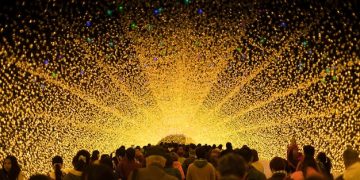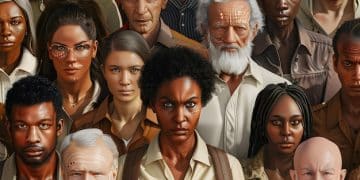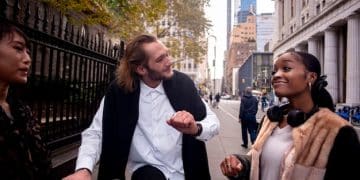The Role of Music Festivals in Shaping Contemporary American Culture
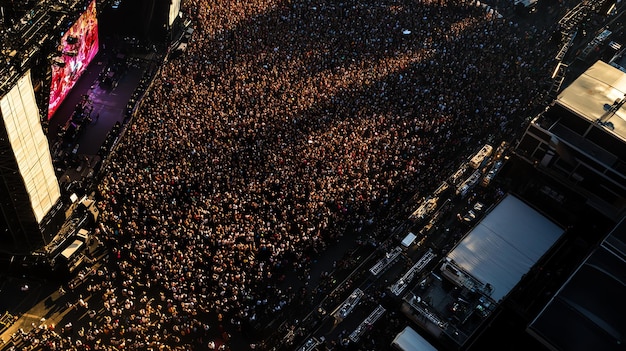
Music festivals significantly shape contemporary American culture by acting as melting pots for various musical genres, fashion trends, social movements, and technological advancements, fostering unique communal experiences that reflect and influence societal values.
The Role of Music Festivals in Defining Contemporary American Culture is multifaceted, encompassing music, fashion, social trends, and technology. These events serve as cultural barometers, reflecting and influencing the values and beliefs of American society.
The Evolution of Music Festivals in America
Music festivals in America have evolved considerably, from small gatherings centered around folk and blues to large-scale events showcasing a wide range of genres. This evolution reflects the changing tastes and demographics of American society.
Early Music Festivals and Their Cultural Impact
Early music festivals, such as the Newport Folk Festival and the Monterey Pop Festival, played a crucial role in popularizing folk and rock music, while also providing a platform for social commentary and activism.
The Rise of Mega-Festivals
The rise of mega-festivals like Coachella and Lollapalooza marked a shift towards larger, more commercial events, catering to a broader audience and featuring diverse musical acts.
- Woodstock (1969): A pivotal counter-culture event that symbolized peace, love, and music, influencing generations.
- Monterey Pop Festival (1967): Introduced many iconic rock acts to a wider American audience.
- Newport Folk Festival (1959-present): Celebrates folk music traditions and often features influential artists.
- Coachella (1999-present): One of the largest and most diverse music festivals blending various genres from pop, hip-hop, electronic, and rock.
The evolution of music festivals mirrors America’s cultural shifts, from folk traditions to diverse genres and larger-than-life commercial events.
Music Festivals as Economic Drivers
Music festivals have become significant economic drivers for local communities, generating revenue through tourism, job creation, and increased business activity. This economic impact is often a major consideration for cities and towns hosting these events.
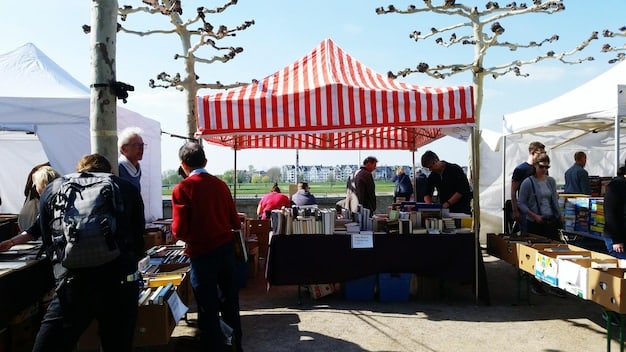
Tourism and Hospitality
Music festivals attract thousands of visitors, boosting tourism and the hospitality industry. Hotels, restaurants, and transportation services benefit from the increased demand during festival weekends.
Job Creation and Local Businesses
These festivals generate numerous jobs, from event staff and security personnel to vendors and local business owners. This employment provides economic opportunities for residents.
Music festivals are more than just cultural events; they are engines of economic growth, benefiting local communities through increased tourism, job creation, and business opportunities.
The Fashion and Style of Music Festivals
Music festivals have become synonymous with unique fashion trends and styles, influencing mainstream fashion and providing a platform for self-expression. Festival fashion often reflects the diverse musical genres and subcultures present at these events. The fashion trends are influenced by the music and attendees will dress to express themselves.
Boho Chic and Festival Fashion
Boho chic, characterized by flowing dresses, floral prints, and vintage accessories, has become a staple of festival fashion, reflecting a carefree and bohemian spirit.
Street Style and Emerging Trends
Music festivals serve as a breeding ground for street style and emerging fashion trends. Attendees often experiment with bold colors, unique patterns, and avant-garde designs, setting trends that eventually trickle into mainstream fashion.
- Bohemian styles: Flowing dresses, floral prints, and vintage accessories.
- Edgy and alternative looks: Leather jackets, ripped jeans, and band tees.
- Futuristic and techno-inspired outfits: Reflecting the electronic music scene.
- DIY and upcycled clothing: Showcasing creativity and sustainability.
From boho to edgy, music festivals are a fashion spectacle, where individual expression and trendsetting go hand in hand.
Social and Political Activism at Music Festivals
Music festivals have a long history of serving as platforms for social and political activism, providing a space for advocacy, awareness campaigns, and community organizing. Many festivals incorporate activism. By raising awareness, advocating for social change, and providing platforms. Music and activism have been intertwined creating unique communal experiences.
Activism Through Music
Many artists use their performances to address social and political issues, using their music as a powerful tool for change.
Awareness Campaigns and Social Initiatives
Festivals often host booths and workshops promoting various social causes, such as environmental sustainability, human rights, and social justice.
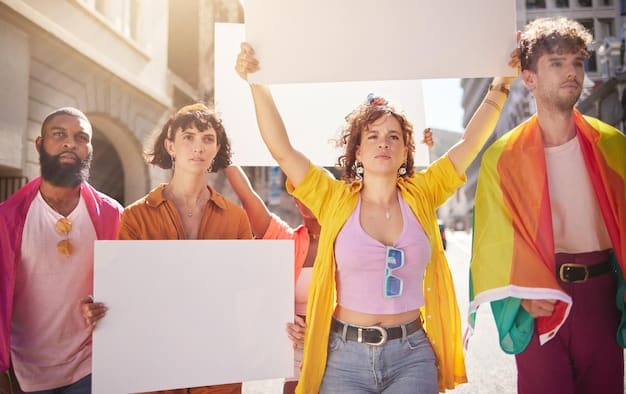
Music festivals unite music with social consciousness, driving awareness and action towards a better world.
The Influence of Technology on Music Festivals
Technology has profoundly transformed the music festival experience, from ticketing and logistics to stage production and audience engagement. These technological advancements enhance the festival experience.
Ticketing and Logistics
Online ticketing platforms and mobile apps have streamlined the ticketing process, making it easier for attendees to purchase and manage their tickets. Enhanced logistics improve overall convenience.
Stage Production and Visual Effects
Advancements in stage lighting, sound systems, and visual effects have elevated the live performance experience, creating immersive and visually stunning shows. Stage production is now a key component of the overall festival experience
- Live streaming: Allows fans to experience festivals from anywhere in the world.
- Mobile apps: Provide schedules, maps, and real-time updates.
- Interactive installations: Engage attendees in unique and memorable ways.
- Social media integration: Enhances sharing and community building among attendees.
Technology enhances every facet of the music festival, engaging attendees in new and interactive ways.
Music Festivals and the Creation of Community
Music festivals foster a sense of community and belonging, bringing together people from diverse backgrounds who share a common love for music and shared experiences. This sense of community is a key component of the festival experience. Music festivals offer unique experiences.
Shared Experiences and Collective Memories
Attending a music festival creates shared experiences and collective memories, forging bonds between attendees who experience the same performances, art installations, and social interactions.
Building Social Connections and Friendships
Music festivals provide opportunities for people to meet new friends, connect with like-minded individuals, and build lasting social connections. These connections can evolve to long lasting friendships.
The Future of Music Festivals
The future of music festivals is likely to be shaped by emerging trends such as sustainability, virtual reality integration, and increased diversity and inclusivity. Music festivals will continue to evolve.
Sustainability and Environmental Responsibility
Many festivals are adopting sustainable practices, such as reducing waste, using renewable energy, and promoting eco-friendly transportation options. These sustainable practices will evolve and improve.
Virtual Reality and Immersive Experiences
Virtual reality technology is being used to create immersive festival experiences, allowing fans to participate in virtual concerts and engage with artists in new ways. This technology is expected to progress and improve.
| Key Aspect | Brief Description |
|---|---|
| 🎶 Music Evolution | From folk to diverse genres like pop, rock, and hip-hop. |
| 💰 Economic Impact | Boost local economies through tourism, jobs, and business opportunities. |
| 💃 Fashion Trends | Influence mainstream fashion with unique styles. |
| 🌱 Social Activism | Serve as platforms for various social and political causes. |
FAQ
Some include Coachella, Lollapalooza, Austin City Limits, Bonnaroo, and Electric Daisy Carnival. These festivals feature a variety of music genres and attract attendees from all over the world.
Music festivals boost local economies through tourism, hotels, restaurants, and local transportation, and creating various jobs, benefitting many residents.
Popular trends include bohemian styles, DIY fashion, sustainable clothing, and futuristic outfits. Attendees often express themselves through unique and creative looks.
Social causes are promoted through artist performances, booths, workshops, and awareness campaigns. Festivals often partner with organizations to support and advocate for specific issues.
Technology is also used for ticketing, navigation, live streaming, and immersive experiences. These advancements enhance convenience, engagement, and overall experience of attendees.
Conclusion
In conclusion, the role of music festivals in defining contemporary American culture is significant, reflecting the evolution of music, fashion, social activism, and technology. By fostering community and driving economic growth, these events continue to shape the cultural landscape of the United States, reflecting and influencing societal values.
